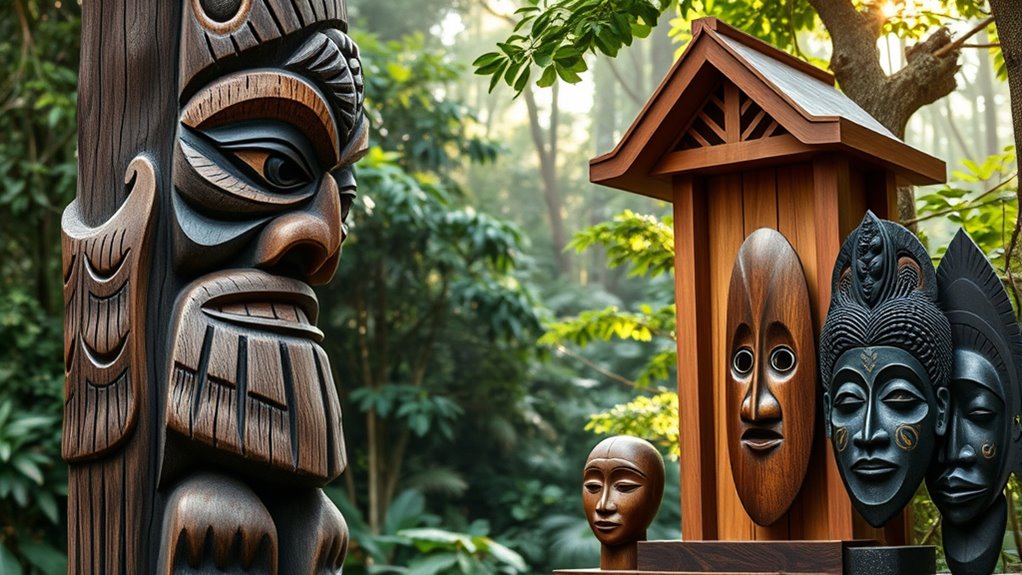Wood holds deep symbolism across cultures, representing life, rebirth, and divine connection. Sacred trees like yew, oak, and Bodhi serve as spiritual links and guardians, while specific species symbolize strength, wisdom, or renewal. Rituals often incorporate wooden artifacts and carvings to honor ancestors, protect communities, or seek enlightenment. If you explore further, you’ll uncover how these symbolic meanings shape traditions, art, and spiritual practices worldwide, revealing the profound cultural role of sacred wood.
Key Takeaways
- Different cultures associate specific woods like oak, yew, and cedar with strength, protection, and divine power.
- Wooden objects such as masks, jewelry, and ritual tools serve as spiritual symbols and cultural identifiers.
- Sacred trees and wood parts are used in rituals to invoke divine energy, healing, and spiritual protection.
- The symbolism of wood reflects themes of life, rebirth, enlightenment, and eternal cycles across various traditions.
- Indigenous and tribal communities see carved wooden artifacts as links to ancestors, spiritual guardians, and cultural continuity.
The Spiritual Significance of Sacred Woods

Sacred woods like yew, oak, and cedar hold deep spiritual significance across many cultures because they are believed to connect the physical world with divine domains. These trees are often central to rituals, serving as conduits for divine energy and spiritual communication. In various traditions, sacred woods symbolize protection, renewal, and wisdom, making them essential in ceremonies and offerings. Indigenous cultures see certain trees as living ancestors or spiritual guides, emphasizing their role as links between worlds. The Bodhi tree, under which Buddha attained enlightenment, exemplifies this connection to spiritual awakening. When used in rituals, these sacred woods invoke divine energy, fostering healing, protection, and deeper spiritual insight, reinforcing their revered status across different faiths and traditions. Additionally, the use of aesthetic wall organization can enhance sacred spaces, creating an environment conducive to meditation and spiritual reflection. Recognizing the spiritual significance of trees deepens our understanding of their role in connecting humans with the divine. Moreover, the consistency of these beliefs highlights how sacred woods serve as natural symbols of spiritual transformation in many cultures.
Trees as Symbols of Life and Rebirth in Mythology
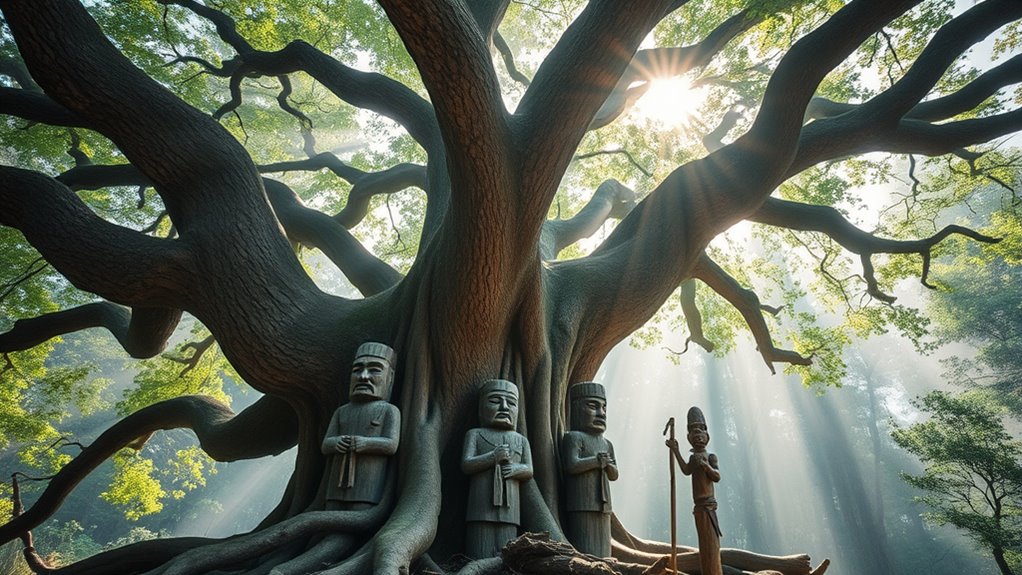
Throughout history, many cultures see trees as powerful symbols of life, renewal, and eternal cycles. You’ll find stories of sacred trees acting as guardians of spiritual rebirth and transformation. These mythological trees remind us of nature’s ongoing cycle of death and rebirth that sustains life. Recognizing the symbolic significance of trees can deepen our understanding of how these natural elements embody cultural values and spiritual beliefs. Many traditions also emphasize the importance of respecting natural resources, highlighting the need to preserve these symbols for future generations. Cultivating an awareness of spiritual energy in nature can strengthen our connection to the environment and inspire more mindful stewardship. Understanding sustainable living practices can deepen our appreciation for how nature’s cycles support human well-being and cultural traditions. Additionally, awareness of regional differences in symbolism can enrich our appreciation of how various societies interpret these natural icons.
Eternal Growth Cycles
Trees serve as powerful symbols of life’s eternal cycle, representing both death and rebirth across many cultures. They embody spiritual renewal, reminding us that growth continues even after setbacks. In Norse mythology, Yggdrasil connects worlds, symbolizing the ongoing cycle of life. The Celtic reverence for sacred oaks reflects their role in spiritual rebirth. The Japanese cherry blossom signifies fleeting life and seasonal renewal, illustrating life’s transient beauty. Egyptian mythology’s Tree of Life stands for everlasting life, with deities emerging from it. Indigenous traditions see specific trees as gateways to spiritual rebirth, emphasizing interconnectedness. The integration of symbolism across cultures highlights the universal human desire for renewal and continuity. Additionally, studies on hydrotherapy demonstrate water’s role in physical and spiritual healing processes. Recognizing the importance of sacred trees in various traditions underscores their significance as symbols of renewal and connection to the divine. The enduring symbolic significance of trees across civilizations illustrates their universal role in representing life’s perpetual renewal. The following table visualizes these symbols:
| Culture | Tree Symbol | Meaning |
|---|---|---|
| Norse | Yggdrasil | Eternal cycle of life |
| Celtic | Sacred oak | Spiritual rebirth |
| Japanese | Cherry blossom | Transient life, renewal |
| Egyptian | Tree of Life | Eternal renewal |
| Indigenous | Sacred gateway trees | Spiritual rebirth, cycle |
Sacred Tree Guardians
Have you ever wondered why certain trees are regarded as protectors and symbols of renewal across cultures? Sacred trees serve as spiritual guardians, embodying divine strength and life’s eternal cycle. Ancient civilizations, like the Norse with Yggdrasil, saw the world tree as the cosmic axis linking all domains, representing ongoing rebirth. The Celts revered the Oak for its divine power, guarding life and symbolizing renewal. In Egyptian mythology, the Tree of Life, often an acacia or sycamore, stood as a divine symbol of rebirth and resurrection. Indigenous cultures worldwide view trees like the Baobab or Cedar as living protectors, embodying ancestral wisdom and spiritual strength. These sacred trees remain powerful symbols of life, endurance, and the ongoing cycle of renewal. Materials such as ceramic and recycled products are often used to create decorative planters that celebrate the beauty and symbolism of nature. Additionally, the sacredness of trees emphasizes the importance of sustainable practices in preserving their sacred status for future generations.
Cultural Meanings of Specific Tree Species
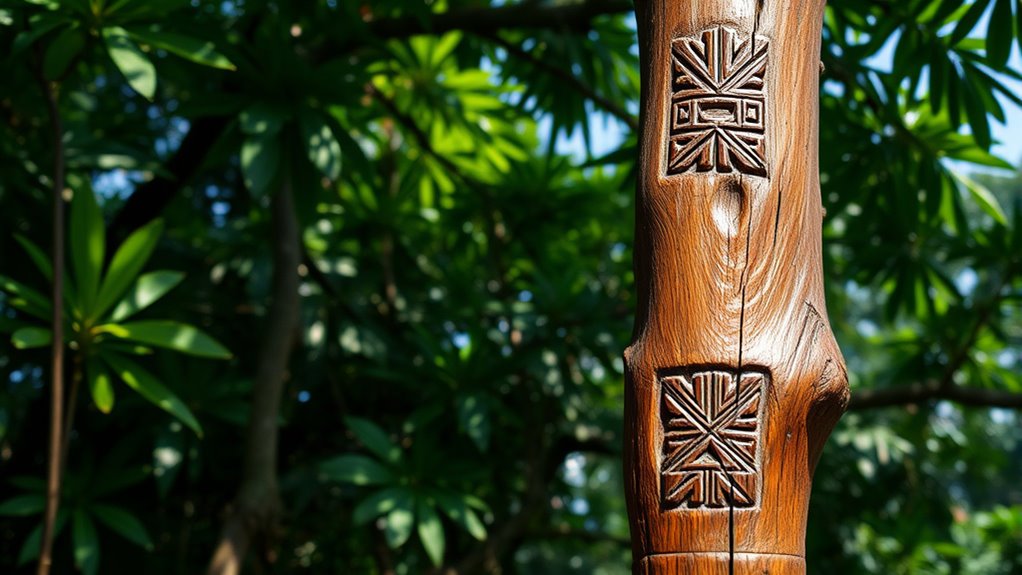
Different tree species carry distinct cultural meanings that reflect their significance in various societies. Sacred trees like oaks symbolize strength, wisdom, and steadfastness, often linked to ancient rituals and spiritual meanings. The Yew tree holds deep symbolism related to death, eternal life, and protection against evil spirits, especially in Celtic and Christian folklore. Cherry blossoms in Japan celebrate life’s fleeting beauty, embodying transience and renewal. Olive trees symbolize peace, wisdom, and healing, prominent in Mediterranean cultures like Greece and Rome. Birch trees represent renewal, purification, and new beginnings, often associated with spiritual rebirth in Celtic and Russian traditions. These trees serve as powerful symbols in cultural narratives, connecting nature’s language to human spirituality and collective memory. Recognizing the cultural symbolism of trees helps deepen our understanding of their importance in human history and traditions. Additionally, the significance of specific tree species often varies across different regions, reflecting local histories and spiritual beliefs. Understanding these symbolic meanings can enrich our appreciation of nature’s role in cultural identity and practices. Moreover, incorporating creative practices such as storytelling and art can help preserve and communicate these symbolic associations to future generations. Studying the historical importance of trees reveals how deeply intertwined nature and cultural identity are across civilizations.
The Role of Trees in Rituals and Ceremonial Practices

Throughout many cultures, specific trees serve as essential focal points in rituals and ceremonial practices, embodying spiritual and symbolic significance. Sacred trees like the yew and oak often mark ceremonial sites where offerings, prayers, and rites are performed to honor deities or ancestors. These trees act as conduits for spiritual communication, helping practitioners connect with higher powers or spirits. In ritual practices, trees such as the birch and lime are believed to embody divine qualities, facilitating healing, divination, or protection. Sacred groves and tree groves serve as natural shrines, reinforcing cultural traditions and spiritual beliefs. By integrating parts of trees—branches, leaves, or carved symbols—communities invoke blessings, ward off evil, and deepen their spiritual connection through these sacred trees. The significance of carrier oils in aromatherapy highlights how natural elements like trees are valued for their healing and spiritual properties across cultures. Additionally, the symbolic importance of specific tree species often guides the choice of trees used in various ceremonial contexts, emphasizing their cultural relevance.
Tree Symbolism in Indigenous and Tribal Traditions
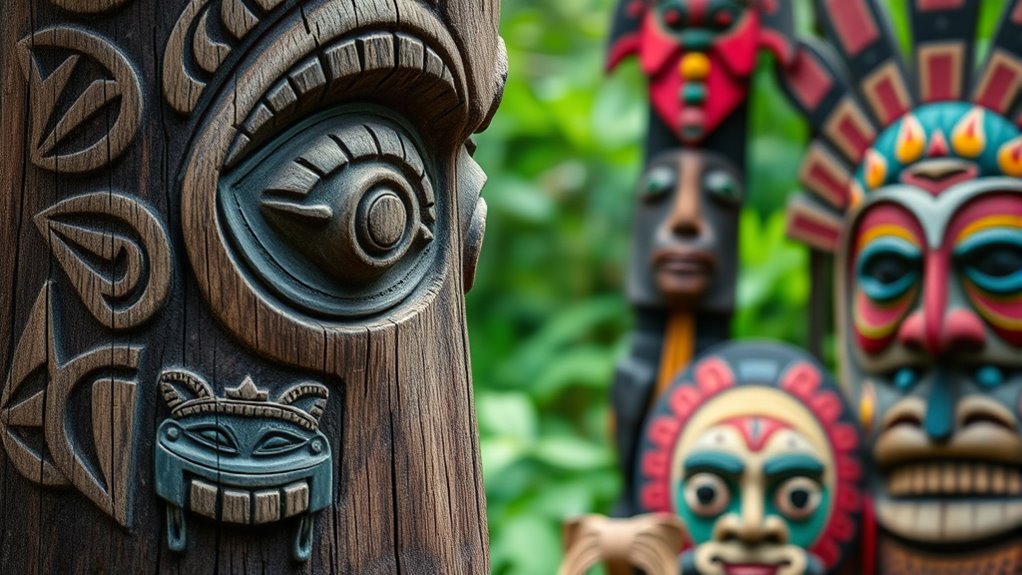
You’ll find that many indigenous and tribal cultures see certain trees as sacred symbols of life, ancestors, and spiritual bonds. They use carved wooden objects and ritual items to connect with these spiritual meanings and cultural traditions. These trees often serve as powerful symbols of protection, identity, and community in their practices.
Sacred Tree Roles
Many indigenous and tribal cultures see sacred trees like the oak, yew, and birch as powerful symbols that embody spiritual connection, protection, and life’s cycle. These sacred trees serve essential roles in their communities, often acting as sites for ritual practices or symbols of ancestral presence. You may find that ritual ceremonies revolve around these trees, which are believed to hold spiritual power, offering guidance and healing. Sacred trees also represent a deep connection to cultural heritage, embodying stories, traditions, and collective identity. They are seen as living ancestors or spirits, guardians of wisdom and sources of renewal. Their significance underscores the interconnectedness of all living beings and highlights the crucial role trees play in maintaining spiritual and cultural continuity.
Ritual and Symbolic Uses
Indigenous and tribal cultures worldwide actively incorporate specific woods into their rituals to establish spiritual connections and convey symbolic meanings. Sacred trees like yew, ash, cherry blossom, and the Bodhi tree play central roles in these practices, representing themes of death, renewal, enlightenment, and divine contact. In ceremonies, communities often use wood from sacred trees to create rituals such as offerings, blessings, or symbolic acts that honor nature’s spirits. For example, Pacific Islanders craft wooden rings from koa and breadfruit, symbolizing ancestral ties and spiritual harmony. Native American tribes carve wooden jewelry from cedar and juniper, embedding meanings of land, protection, and fertility. These ritual uses of wood reinforce cultural identity, foster spiritual communication, and deepen the connection with nature’s sacred elements.
The Connection Between Trees and Divine Powers

Throughout history, trees have served as powerful symbols connecting humans to divine forces. Sacred trees like the oak and yew are believed to embody divine powers, acting as spiritual links between people and deities. The world tree, Yggdrasil in Norse mythology, represents the divine axis connecting the heavens, earth, and underworld, emphasizing its spiritual significance. Celtic traditions honor trees such as Rowan and Beech as manifestations of divine wisdom and protection, embodying spiritual energy. In Chinese culture, the Bodhi tree symbolizes enlightenment and divine insight, serving as a physical representation of spiritual awakening. Many indigenous beliefs see trees as living spirits or divine entities, mediating between human worlds and divine spheres, reinforcing their sacred connection across cultures.
The Use of Wooden Artifacts in Ancient Societies
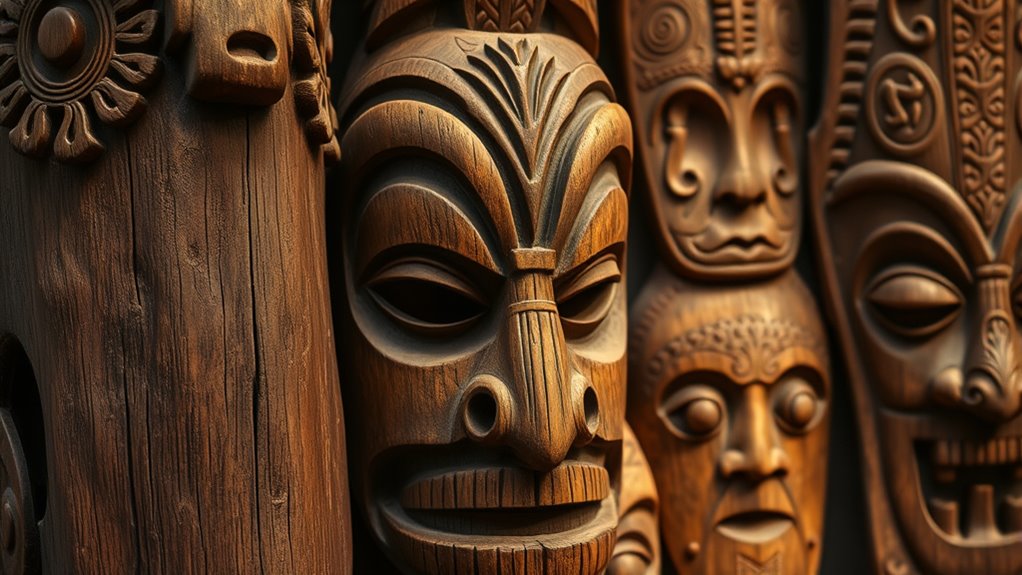
Trees have long been revered as symbols of spiritual connection, and this reverence extends to the artifacts crafted from their wood. In ancient societies, wood was a versatile material used for tools, ritual objects, and ornaments. These artifacts played a crucial role in cultural practices and spiritual rituals. For example:
Trees symbolize spiritual connection, inspiring ancient tools, rituals, and sacred objects across cultures.
- Wooden rings and jewelry served as symbols of status and spiritual significance across civilizations like Egypt and Mesopotamia.
- Carved wooden figurines and idols in Neolithic sites held ceremonial and spiritual importance.
- Indigenous communities created masks, amulets, and relics from local wood, embodying their spiritual beliefs and cultural identities.
The durability and natural symbolism of wood made it a core material for sacred objects, connecting people to their ancestors and divine powers.
Modern Interpretations of Tree Symbolism in Art and Jewelry

Modern artists and jewelers draw upon the rich symbolism of trees by incorporating woods like oak, cherry, and olive into their work to evoke themes of strength, love, and wisdom. The Tree of Life remains a powerful symbol, often featured in modern art and jewelry to represent interconnectedness and renewal. Contemporary designs include wooden rings and pendants engraved with culturally significant tree symbols, blending tradition with modern aesthetics. Many artists emphasize sustainability by using reclaimed or responsibly sourced wood, highlighting an environmental consciousness alongside spiritual meaning. Abstract and minimalist pieces utilize wood motifs to visually express growth and interconnectedness. Exhibitions showcase how ancient tree symbolism continues to inspire and adapt within modern art and jewelry, reaffirming the enduring significance of trees in our visual and cultural landscape.
Frequently Asked Questions
What Do Different Types of Wood Symbolize?
You wonder what different types of wood symbolize. Oak represents strength and steadfastness, making it a symbol of protection and kingship. Cherry and apple woods stand for love, passion, and renewal, embodying beauty and emotional harmony. Rowan, hazel, and yew connect to magic, protection, and spiritual domains. Bamboo and beech symbolize resilience, growth, and wisdom, while cedar, walnut, and madrone reflect healing, protection, and knowledge.
What Do the Woods Symbolize?
When you ask what woods symbolize, you’re exploring their deep meanings across cultures. Woods often represent strength, endurance, and a connection to nature. They stand for stability, resilience, and life itself. Different kinds of wood carry specific spiritual messages—oak for protection, birch for renewal, cherry for love. You can see their symbolic power in mythology, rituals, and stories, showing how closely they tie humans to the natural world.
What Emotions Does Wood Represent?
Think of wood as a silent storyteller, whispering emotions through its grains. You might feel love when holding Myrtle, peace with Olive, or hope from Birch. Different woods evoke feelings like joy, protection, or calmness, shaping your mood and spiritual connection. By choosing specific types of wood, you invite these emotions into your life, letting nature’s language guide your inner world and deepen your understanding of yourself.
What Does Wood Symbolize in a Relationship?
In a relationship, wood symbolizes strength, stability, and enduring commitment. You see it in wooden rings and jewelry, representing loyalty and eternal love because of its durability. The unique grain patterns and natural imperfections remind you to accept each other’s flaws and individuality. When you choose reclaimed or sustainable wood, it also reflects your respect for nature and shared values, reinforcing the deep, resilient bond you’re building together.
Conclusion
Now that you’ve seen how different cultures cherish trees as symbols of life, rebirth, and divine connection, it’s clear their significance goes beyond mere wood. They embody spiritual beliefs, cultural identities, and sacred traditions. As you reflect on this, ask yourself: isn’t it remarkable how something as simple as a tree can carry so much meaning across time and societies? Perhaps, in understanding their symbolism, you also connect more deeply with the universal language of nature.
